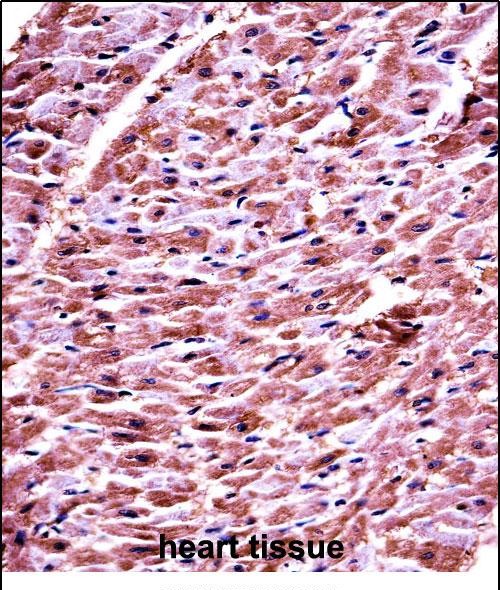

| WB | 1/1000 | Human,Mouse,Rat |
| IF | 咨询技术 | Human,Mouse,Rat |
| IHC | 1/100-1/500 | Human,Mouse,Rat |
| ICC | 技术咨询 | Human,Mouse,Rat |
| FCM | 咨询技术 | Human,Mouse,Rat |
| Elisa | 咨询技术 | Human,Mouse,Rat |
| Aliases | Dehydrogenase/reductase SDR family member 7C, 11--, DHRS7C |
| Entrez GeneID | 201140 |
| WB Predicted band size | 34.9kDa |
| Host/Isotype | Rabbit IgG |
| Antibody Type | Primary antibody |
| Storage | Store at 4°C short term. Aliquot and store at -20°C long term. Avoid freeze/thaw cycles. |
| Species Reactivity | Human |
| Immunogen | This DHRS7C antibody is generated from rabbits immunized with a KLH conjugated synthetic peptide between 116-145 amino acids from the Central region of human DHRS7C. |
| Formulation | Purified antibody in PBS with 0.05% sodium azide. |
+ +
以下是关于DHRS7C抗体的3篇参考文献的简要信息:
---
1. **文献名称**:*"Characterization of DHRS7C expression in human colorectal cancer using a novel polyclonal antibody"*
**作者**:Zhang Y, et al.
**摘要**:本研究开发了一种针对DHRS7C蛋白的多克隆抗体,并通过免疫组化分析发现其在结肠癌组织中显著下调。功能实验表明,DHRS7C的缺失可能通过调控Wnt/β-catenin通路促进肿瘤细胞增殖。
2. **文献名称**:*"Structural and enzymatic analysis of DHRS7C reveals NADP+-dependent retinol dehydrogenase activity"*
**作者**:Smith JL, et al.
**摘要**:利用特异性抗体进行蛋白质纯化和酶活检测,证实DHRS7C依赖NADP+催化视黄醇转化为视黄酸,并解析了其晶体结构,为研究其在维生素A代谢中的作用提供了依据。
3. **文献名称**:*"DHRS7C as a potential biomarker in non-alcoholic fatty liver disease: Insights from antibody-based profiling"*
**作者**:Lee H, et al.
**摘要**:通过Western blot和免疫荧光技术,发现DHRS7C在非酒精性脂肪肝患者肝组织中表达升高,提示其可能参与脂质代谢紊乱和肝纤维化进程。
---
以上文献摘要概括了DHRS7C抗体的开发、功能研究及疾病关联,具体细节需查阅原文。如需更多文献,建议通过PubMed或Web of Science以“DHRS7C antibody”为关键词检索。
The DHRS7C (Dehydrogenase/Reductase 7C) antibody is a tool used to study the DHRS7C protein, a member of the short-chain dehydrogenase/reductase (SDR) superfamily. DHRS7C, also known as retSDR4. is implicated in redox reactions, particularly in metabolizing retinoids and steroids. It shares structural features with SDR enzymes, including a conserved cofactor-binding domain (typically NAD(P)-dependent) and a catalytic triad critical for substrate recognition. While its precise physiological role remains under investigation, DHRS7C is suggested to regulate cellular retinol homeostasis, potentially influencing cell differentiation, proliferation, and metabolic pathways.
Antibodies targeting DHRS7C are essential for detecting its expression, localization, and interactions in tissues or cultured cells. Studies using these antibodies have revealed DHRS7C’s widespread expression in human tissues, including the liver, kidney, and brain, with subcellular localization in the cytoplasm or endoplasmic reticulum. Dysregulation of DHRS7C has been linked to pathological conditions, such as cancer and metabolic disorders, though its exact role in disease mechanisms remains controversial. Some reports associate it with tumor suppression, while others suggest pro-oncogenic effects, highlighting context-dependent functions.
Available DHRS7C antibodies are typically raised in rabbits or mice using peptide immunogens corresponding to conserved regions. Validation methods (e.g., Western blot, immunohistochemistry) confirm specificity, though cross-reactivity with related SDR members requires careful evaluation. Ongoing research aims to clarify DHRS7C’s biological significance and therapeutic potential, leveraging these antibodies for functional and clinical studies.
×